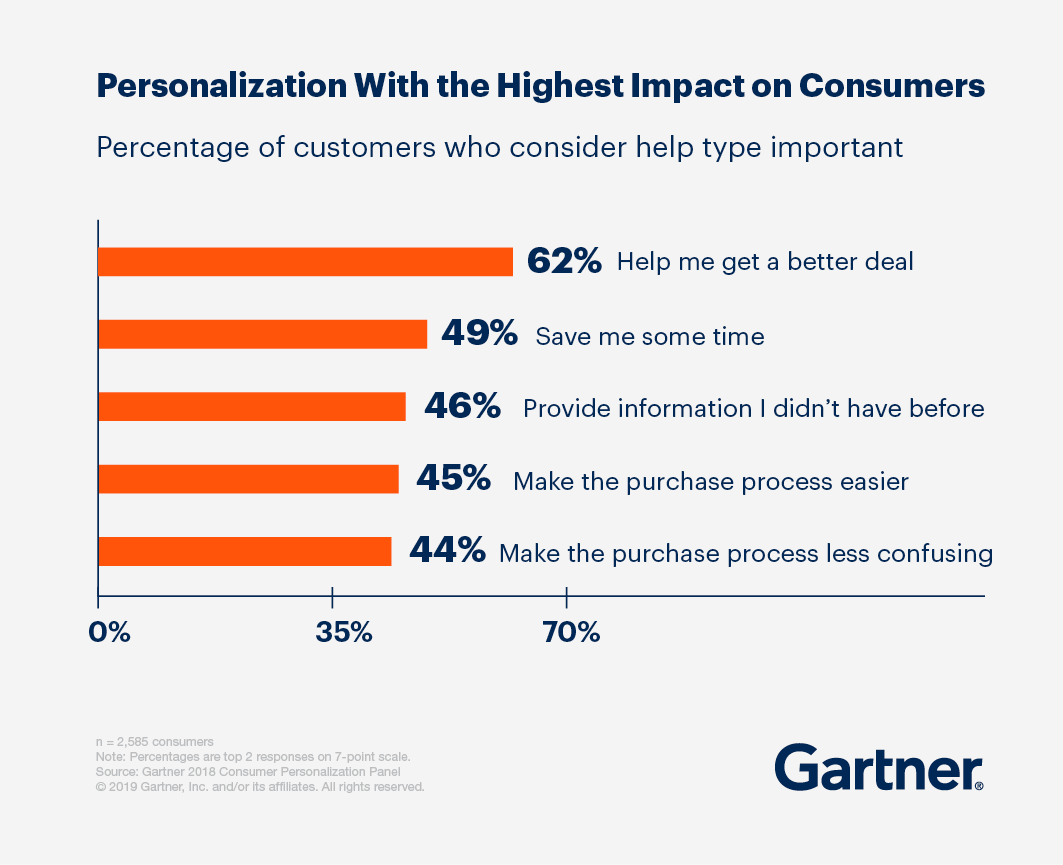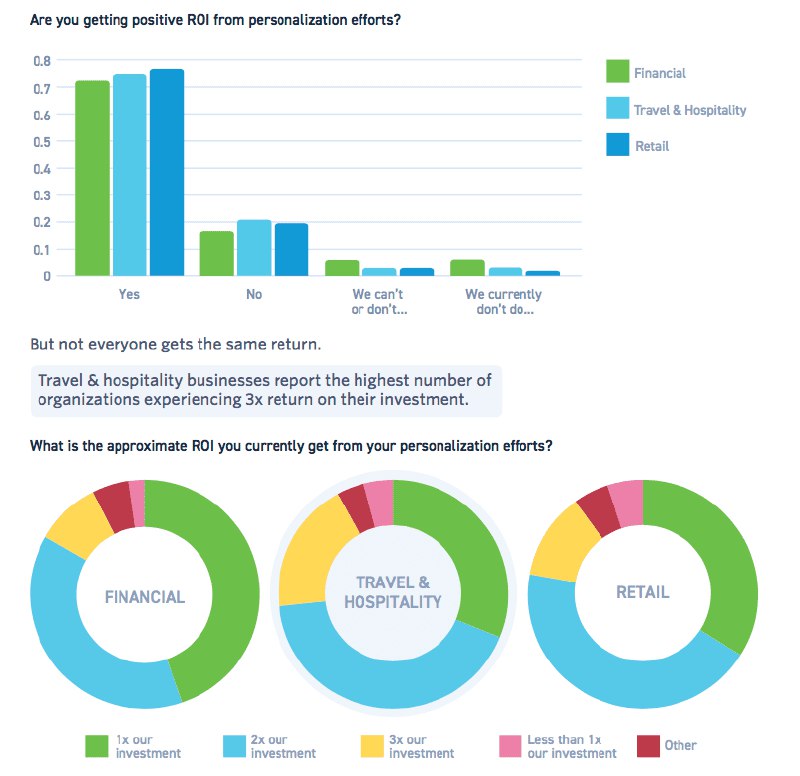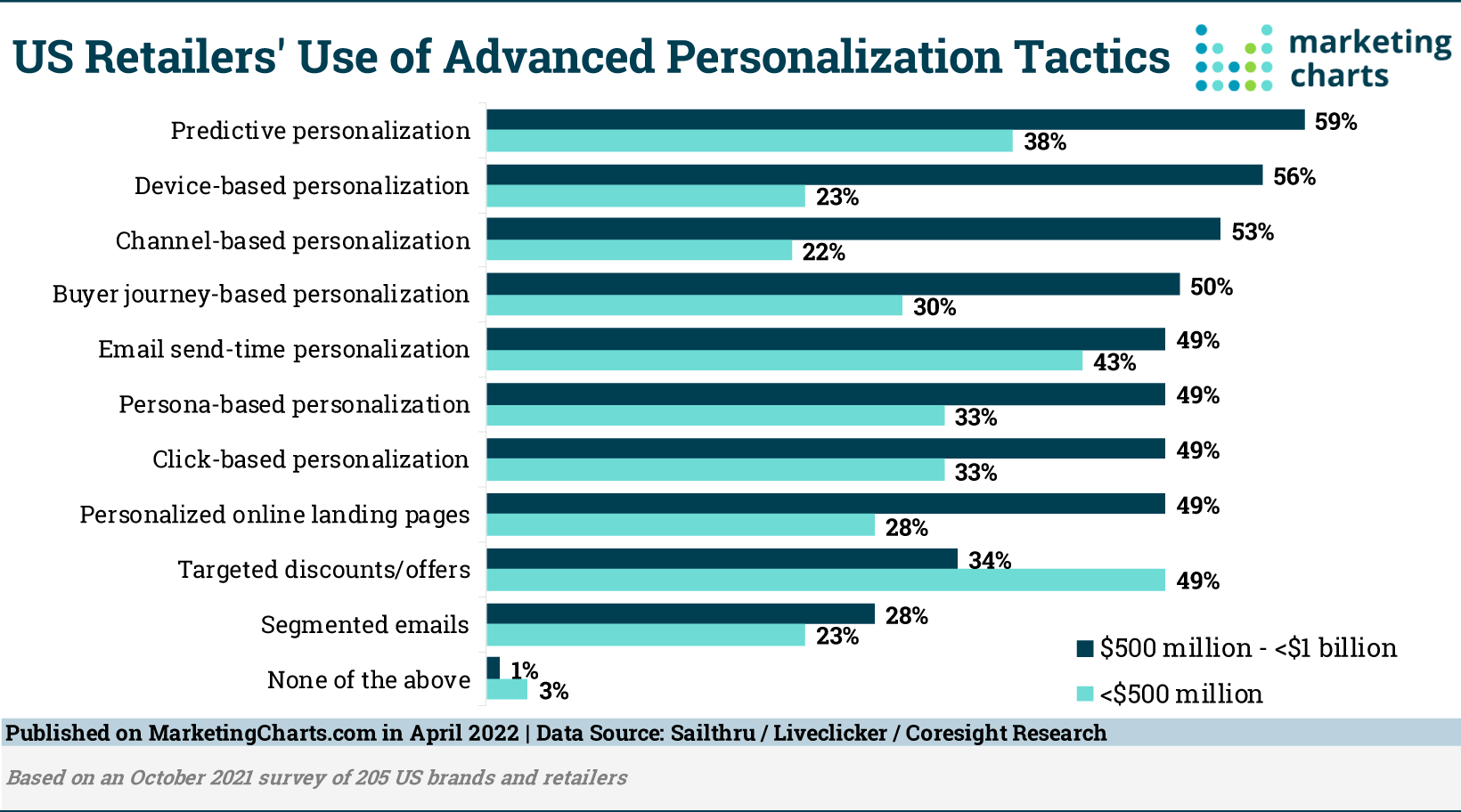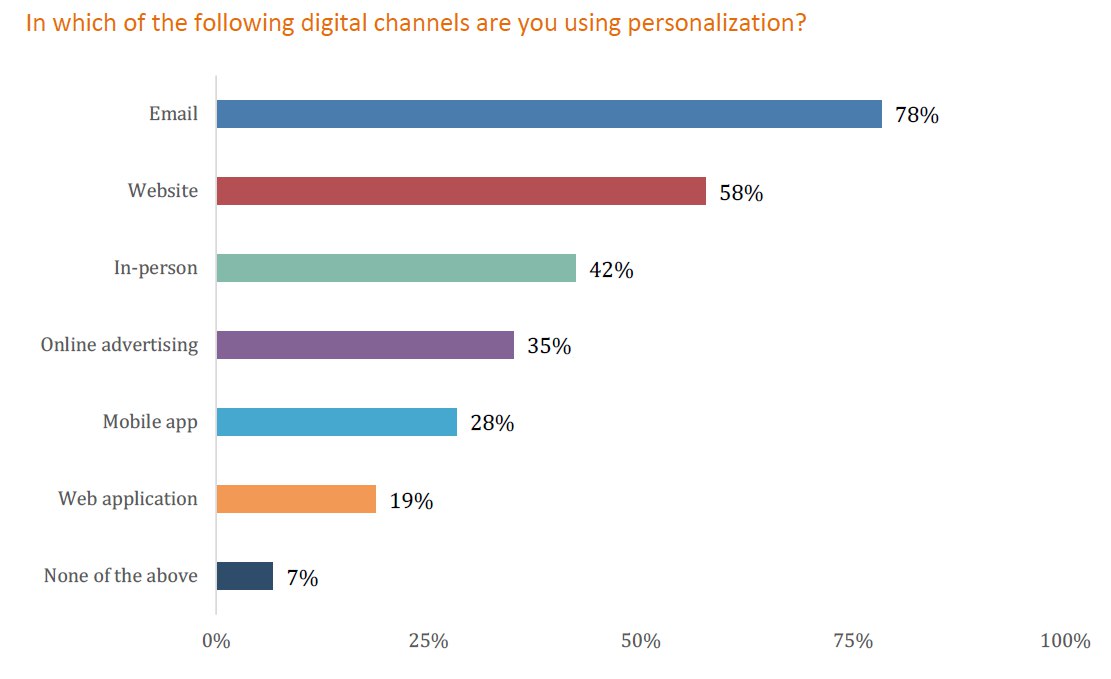Want to skyrocket customer engagement and stop serving every website visitor the same stale, generic content? Website content personalization is the key.
Businesses need to find ways to stand out and deliver a superior customer shopping experience and tailoring and personalizing your website’s content to each visitor’s unique interests and preferences delivers outstanding results. This isn’t just something “other companies” do. You can transform your own website into a customized powerhouse that leaves a lasting impression on visitors and wins their business.
By personalizing your website, you create specialized experiences for every visitor. No more one-size-fits-all content. You can customize everything from written content to images, CTAs, banners, product recommendations, and more.
“If we have 4.5 million customers, we shouldn’t have one store. We should have 4.5 million stores.” CEO of Amazon Jeff Bezos about the importance of Web Personalization
Web personalization is essential in business because today’s buyers are more informed than ever, and buying decisions are complex and involve multiple stakeholders.
Customers nowadays expect a personalized experience when researching online and have specific goals. By using dynamic web personalization strategies to guide them to their objectives, you can foster brand loyalty and optimize their sales funnel. Additionally, tailoring the messaging to each website visitor based on their buying stage is essential; this can lead to a better customer experience and a smoother conversion process.
Website personalization can improve the online presence of a business and boost its sales. By creating a customized experience for website visitors, companies may increase engagement, traffic, and conversions. 93% of companies notice a conversion rate increase as a result of website personalization.
Several studies have shown that personalized content on websites has the following impact:
Website personalization simplifies the user’s online experience, making it more convenient and enjoyable; this leads to more repeat customers, with 70% of consumers saying that a company’s understanding of their needs influences loyalty.
Additionally, 87% of consumers say personally relevant business content positively impacts how they feel about a brand, while 74% feel frustrated when website content is not customized and personalized according to their needs.

Image Source is smartinsights.com
Personalized website content has been shown to dramatically improve performance across key metrics for both B2B and B2C companies. Personalized content for B2B websites can deliver higher conversion rates, increased sales, lower bounce rates, and greater customer engagement. One report found that personalized content meets objectives nearly 50% of the time for B2B companies. Over 60% of businesses surveyed are actively using content personalization strategies. For those implementing on-site personalization, the effectiveness is remarkably high.
The reason personalized website performs so well is that it provides a more relevant, engaging experience for each visitor. Website visitors want content that speaks directly to their needs and interests. Personalized content delivers that precise messaging, keeping visitors on site longer and moving them towards conversions.

What is the Impact of Web Personalization? | Image Source is Gartner
The following are the benefits of on-site personalization:
One of the main benefits of web personalization for businesses is to help optimize lead quality. When visitors see content relevant to their interests, they are more likely to engage with the website and provide their contact information. By tailoring the user experience and content to individual preferences, web personalization not only enhances lead qualification but also increases the likelihood of capturing high-quality leads who are genuinely interested in your products or services.
The following are practical steps to help optimize lead quality:
Personalization means targeting potential customers with messages and special offers customized to their specific needs and pain points, which leads to enhanced lead generation.
Website personalization can be an effective tool to nurture leads. Potential customers will see different content throughout the pipeline based on their stage. For example, a lead just starting to research a company may be more interested in general information about its products or services. A lead in the process may be more interested in case studies, pricing information, or a free demo.
Converting a lead into a customer can take up to a year in various industries. However, web content personalization can help you focus on the individual needs of each lead, shortening the buying cycle by providing hyper-personalized services, content, and recommendations; this leads to increased deal frequency and faster closures.
A good website personalization strategy also enables sales teams to pursue high-potential clients with data-driven evidence, resulting in better sales outcomes. As a result, sales efficiency improves, with less time invested in cold outreach and more resources spent on nurturing quality leads.
You can engage website visitors more effectively and leave a lasting impression by personalizing the website experience. It keeps potential customers on the website for longer periods and increases the number of pages they visit.
Moreover, you can effectively guide website visitors toward the correct information, contact, or purchase by understanding what users look for. As a result, it becomes easier to define the quality of leads coming through the website, and the sales team can be presented with more ready-made, high-quality leads.
Personalized content on the website can be more effective in generating leads than generic content. This is because customized content is more engaging and appealing to users. Showing people relevant content at different stages of the sales pipeline can encourage them to move on to the next step or convert immediately. This approach helps improve the overall lead conversion rate.

What is the ROI of website personalization? | Image Source is Smart Insights
A personalized call-to-action can be the final deal-breaker for the lead conversion. Here are some practical tips to create engaging calls-to-action:
You can increase users’ time on their website and the number of pages they visit by personalizing it; this, in turn, can boost customer satisfaction and engagement, reduce bounce rates, and lead to long-term loyalty. Good personalized website pages create a more relevant user experience, making customers more likely to return for more. Tracking user engagement metrics, such as click-through rates, session duration, and page views, can provide valuable insights into the effectiveness of your website personalization efforts and help fine-tune your strategies for even better results.
To retain customers, you must understand their needs and provide relevant content, recommended products, and suggestions that align with their browsing or purchase history. Engaging customers with value-added content related to their consumption can help cultivate brand loyalty and encourage them to revisit the website.
Showing customers that the business cares by rewarding loyalty with personalized customer offers and programs is critical. Utilizing personalization and improved user and customer understanding can strengthen the brand’s positive perception and give it a clear competitive advantage.
Personalized website experiences make users feel seen and valued, which is a good way to nurture customer relationships. Customers want to be heard, which is one of the biggest consumer and e-commerce trends for B2B companies. Website personalization will help you gain loyal customers by providing unique experiences.
Personalization can help improve the engagement rate, positively impacting the website’s SEO. Google evaluates whether a visitor leaves the website immediately after landing on it (bounce rate) and how much time they spend on a page (dwell time), as this helps them to determine how relevant the content is. Based on this evaluation, Google assigns a page rank to the website.
When a website provides a personalized experience to its visitors, they are more likely to engage with the content. As a result, the website’s bounce rate will decrease, and its dwell time will increase.

Image Source is netcorecloud.com
Determine the primary conversion goals of your website before you start personalizing the content and experiences. Once you know what you want the visitors to do, you can start thinking about creating a personalized journey that leads to those goals, and ultimately improving your conversion rate optimization efforts for higher success rates.
Here are some of the most common website conversion goals:
Effective decision-making in website personalization requires data analysis. You can gain valuable insights into visitors’ needs and behavior by analyzing website data. The process begins by defining website personalization goals. It is crucial to determine what needs to be achieved. Once goals are defined, you’ll easily identify the most critical data to track.
Data can then be used to identify patterns to understand visitors and their behavior better. It can also be used to test and optimize website personalization strategies. Once areas for personalization are identified, it is essential to experiment with and optimize the strategy.
Website analysis tools provide valuable insights into how visitors interact with a website. They show which pages visitors view, which links they click, and how long they stay on each page. Additionally, conversion rates can be tracked to identify areas where the website performs poorly.
Analyzing this data can identify opportunities to personalize content and improve user experience. For example, if visitors spend a lot of time on a particular page, more content can be added, or the page can be made more engaging. Similarly, if visitors abandon their shopping carts at a certain point in the checkout process, changes can be made to simplify the process and encourage them to complete their purchases.
Online form analytics can provide valuable insights into the leads generated through a website. By examining the information provided by the forms, you’ll understand your target audience and needs. You can use such knowledge to personalize and optimize website landing pages and create more engaging experiences.
For example:
Unless the company is implementing Account-Based Marketing (ABM), it is important to categorize the visitors into suitable segments. It is recommended to use a reliable contact database provider. Many companies serve multiple customer segments from different industries and company sizes. Customers can also be segmented based on whether they use a specific technology.
Once the goals are defined, decide who to target, asking, “Who are the most valued audiences?” It is better to focus on just one or two top segments, informed by their customer personas and ideal customer profiles and what sets them apart.
It’s important to remember that the selected audiences should benefit from and demonstrate an advantage by receiving a specific message or experience.
Personalized marketing is crucial for the success of any business, but it cannot be achieved through a one-size-fits-all approach. Before creating a marketing strategy, it is vital to understand the customers and reach and persuade the target audience.
The company can start by reviewing analytics to identify expected pages with high bounce rates, landing pages with low conversion rates, and user flows; this will give them an idea of where to begin.
With the right tools, data, and messaging, companies can develop a comprehensive sales and marketing strategy that is entirely personalized and connects with buyers on a deeper level. Buyers want actionable solutions to their problems. By personalizing the messaging and content to meet the exact needs of their target audience, the company will be able to drive more ideal prospects into their pipeline, win and retain them, and optimize conversions where they matter.

Image Source is agilitycms.com
To effectively personalize a website, it is important to understand the target audience; this involves comprehensively understanding their demographics, firmographics, needs, and pain points. Once this data is collected, the audience can be segmented into smaller groups based on their needs and interests.
Website personalization for each group can provide the audience with the information and resources they need most, leading to increased engagement, conversions, and customer satisfaction.
Advanced analytics tools can help you gain deeper insights into customers’ needs and preferences. Examples of advanced analytics tools include:
1. Social listening tools
2. Customer relationship management (CRM) systems
3. Machine learning and artificial intelligence (AI) tools
4. Website and Form Analytics Tools
Tracking user behavior and analyzing data is crucial for understanding how people interact with a specific website and forms, and what changes can improve their experience. Google Analytics is a powerful and effective tool that can provide various insights, including demographics, interests, behavior, and goals.
When combined with form analytics tools, you’ll gain a comprehensive understanding of how people interact with your site and forms. Website analytics provides metrics like the number of visitors and sessions, bounce rates, time on page, traffic sources, and more. This shows how people navigate and engage with the content.
Form analytics specifically tracks submissions to see form completion rates, fields commonly left blank, submission times/days, and info entered like name, email, and company. Bringing both website and form analytics together gives you a complete view of your visitors, where they come from, what interests them, how they convert, and where there’s room for optimization. The data highlights opportunities to personalize website content and customize experiences to turn more visitors into high-quality leads and customers.
Buyer personas can be used to help understand their target audience and come up with more personalized content and experiences. To monitor buyer’s journeys, use website analytics tools, form analytics, customer surveys, sales team interviews, and social media monitoring.
Optimizing and personalizing websites is important to generate leads and sales through online presence. However, this task can be complex. To make it easier, here are some tips for optimizing and personalizing.

What Kinds of Advanced Personalization Techniques Are Retailers Engaging In? | Image Source is Marketing Charts
Crafting the right message for the right audience on a website personalization involves using social proof and calls to action. Social proof is the principle that people are more likely to take action if they see others doing it. This can be done by incorporating testimonials from satisfied customers, case studies of successful projects, or highlighting the number of subscribers to a newsletter or social media followers.
Calls to action should be clear and concise, guiding visitors to take the desired action, such as requesting a demo, downloading a white paper, or signing up for a free trial.
This can be divided into three segments:
Targeted messaging can be used by creating different messages for various audience segments. For instance, different messages can be used for executives, managers, and technical users. It is also suggested to use dynamic website personalization methods such as dynamic messaging, which changes based on the visitor’s behavior on the website. For example, visitors on product pages may see messages highlighting product features and benefits, while visitors on pricing pages may see messages about available discounts or limited-time offers. The key is crafting messages relevant to what each visitor is viewing. Personalization can be achieved using the visitor’s name, company name, or other relevant information.
Businesses need to understand their target audience. They should identify who they are trying to reach, their needs, pain points, and goals, and adjust their messaging to resonate with them.
Using clear and concise language is key. Avoid using jargon or technical terms their target audience may not understand. The message should be easy to read and understand, even for people who are not experts in the industry.
Messaging should focus on the benefits the product or service will bring to customers. By highlighting the benefits, you’ll create a strong message that will resonate with the target audience. To make the message more effective, define the company’s value proposition, identifying what makes the company unique and what value you’re offering to the customers.
You can also do the following:
The A/B testing generally means randomly assigning visitors to different versions of a website page to find out which one performs better.
Track key metrics such as bounce rate and time on the page to measure the success of your website or app.
Regularly review your website or app analytics to identify trends and patterns. Always test your landing pages to make sure that you’re effectively capturing and engaging your audience.

The survey by Evergage and Researchscape International shows Website remains the most popular channel for personalization after Email | Image Source is salesforce.com
When website personalization is done right, it creates more relevant, meaningful experiences that drive conversions. Here are a few examples of website personalization:
Amazon, the e-commerce leader, customizes its homepage for each visitor based on past purchases and browsing history. It prominently displays products and categories you’ve shown interest in to cater to your preferences.
Leveraging its expansive user data, Spotify crafts customized messages for specific groups of listeners by auto-generating personalized playlists to align with each user’s musical preferences based on their streaming history. Additionally, Spotify uses this robust data to produce tailored marketing promotions, like dispatching genre-relevant advertisements to fans of particular musical styles.
Airbnb personalizes the experience for its guests and hosts by using tailored email content. For guests, Airbnb may recommend local attractions and activities based on the city they are visiting. This allows guests to plan their trips around sights that they will enjoy. In addition, Airbnb sends emails to hosts leading up to upcoming guest stays to remind the hosts to prepare. The emails also contain helpful suggestions so hosts can continue improving their hosting abilities.
Birchbox, a popular monthly subscription service for beauty products, uses subscriber profile data on individual preferences and skin/hair types. This information allows Birchbox to curate personalized sample boxes tailored to each recipient’s likely product matches.
As inflation and acquisition costs continue to rise, businesses are pressured to maximize their return on investment. It is essential to monitor the results and make adjustments to ensure that the website personalization is effective and goals are being achieved.
Applying website personalization strategies, businesses can create content that effectively communicates with its audience and achieves the desired results.